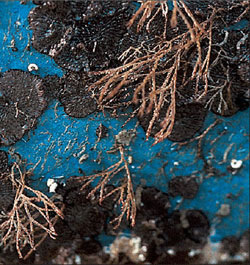Lophophorates
 |
| Ectoprocts and other animals fouling a boat bottom. |
When a plant grows somewhere that humans do not want it to grow, we call it a “weed.” Sessile organisms that settle and grow on pilings, boat hulls, pipes, cables, and other structures placed there by humans are referred to as “fouling organisms.” Since we do not want them there, we might call them the marine equivalent of terrestrial weeds. And like terrestrial weeds, they are very persistent.
Members of one phylum covered in this section, Ectoprocta, are among the most important fouling organisms, especially on ship and boat hulls. Fouling of boat hulls causes turbulence as the vessel proceeds through water, and increased resistance decreases speed of the vessel and increases its fuel consumption. It is costly to scrape the organisms from a boat hull either in dry dock or in water. Consequently, boat hulls have often been painted with paints containing a toxic antifouling agent. One of the most effective of these is a substance called tributyl tin (TBT). After application in paint, TBT is released at a low rate over a long period of time, making scraping and repainting necessary less frequently. Unfortunately, release of the toxin into seawater, especially in harbors and basins where many boats are concentrated, has catastrophic effects on many organisms, particularly bivalves, which concentrate the compound in their tissues.
In 1988 the U.S. Congress passed a law severely restricting use of TBT in antifouling paints, and the problem should be considerably alleviated by this law.
Ironically, eighteenth-century naturalists included ectoprocts (along with cnidarians and some others) in a group designated “zoophytes,” meaning “animal plants.” These early workers thought that zoophytes were akin to both animals and plants. Comparing ectoprocts with plant weeds gives a new meaning to the term zoophytes.
Position in the Animal Kingdom
- Members of lophophorate phyla possess a true coelom, a body cavity lined with a layer of mesodermal epithelium called peritoneum.
- They belong to the protostome branch of the bilateral animals, but they have some characteristics typical of deuterostomes.
- The three phyla are usually grouped together because they all possess a crown of tentacles called a lophophore, which is specialized for sedentary filter feeding. The lophophore surrounds the mouth but not the anus, thus differing from the tentacular crown of Entoprocta.
- The lophophore is a unique ridge that bears hollow, ciliated tentacles, and it is an efficient, specialized filterfeeding device that forms a ciliated route, or trough, for trapping and directing food particles to the mouth.
- Brachiopods and phoronids possess vascular systems for circulation of food nutrients and other materials.
- Blood in phoronids possesses red blood corpuscles that contain hemoglobin for carrying oxygen.
Lophophorates
Phoronida are wormlike marine forms that live in secreted tubes in sand or mud or attached to rocks or shells. Ectoprocta are minute forms, mostly colonial, whose protective cases often form encrusting masses on rocks, shells, or plants. Brachiopoda are bottom-dwelling marine forms that superficially resemble molluscs because of their bivalved shells.
One might wonder why these three apparently different types of animals are lumped together in a group called lophophorates. Actually they have more in common than first appears. They are all coelomate; they have some deuterostome and some protostome characteristics; and none has a distinct head. But other phyla share these characteristics. What really sets this group apart from other phyla is the common possession of a ciliary feeding device called a lophophore (Gr. lophos, crest or tuft, + phorein, to bear).
A lophophore is a unique arrangement of ciliated tentacles borne on a ridge (a fold of the body wall), which surrounds the mouth but not the anus. The lophophore with its crown of tentacles contains within it an extension of the coelom, and the thin, ciliated walls of the tentacles are not only an efficient feeding device but also serve as a respiratory surface for exchange of gases between the environmental water and the coelomic fluid. The lophophore can usually be extended for feeding or withdrawn for protection.
In addition, all three phyla have a U-shaped alimentary canal, with the anus placed near the mouth but outside the lophophore. The coelom is primitively divided into three compartments, protocoel, mesocoel and metacoel, and the mesocoel extends into the hollow tentacles of the lophophore. The protocoel, where present, forms a cavity in a flap over the mouth, the epistome. The portion of the body containing the mesocoel is known as the mesosome, and that containing the metacoel is the metasome. Members of all three phyla have a freeswimming larval stage but are sessile as adults.




